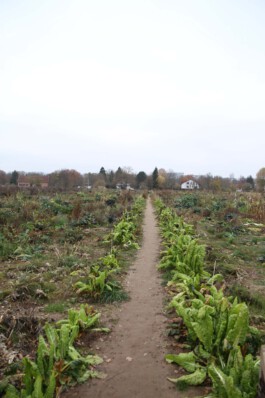EXKURS
LANDSCHAFTEN Für das Projekt spielt der Begriff der Landschaft eine zentrale Rolle. Sie ist als typologische Beschreibung ein wichtiger Kulturbegriff, der oft missinterpretiert wird. Landschaft beschreibt ganz wesentlich den Raum zwischen Mensch und Natur, den Übergang von der Kultur zur Natur. Landschaft ist eine Interimszone, ein Spatium, eine Passage, in der viel mehr die Wechselwirkung zwischen den Dingen bezeichnet werden denn die Dinge an sich.
Landschaft entsteht weitgehend mit der Entfremdung des Menschen von der Natur. Bereits in der romantischen Malerei zeigt sie sich als Raum unüberbrückbarer Distanz, in der der Verlust der Einheit teils nüchtern, teils schwermütig in Szene gesetzt wird. Im Bild Wanderer über dem Nebelmeer von Caspar David Friedrich als Ikone dieser Entwicklung deckt die Rückenfigur das Zentrum des Bildes so weit ab, dass dem Betrachtenden selbst der Blick auf das von ihm Getrennte ver- wehrt wird und er sich nurmehr in sich selbst widerspiegelt. Das Bild stellte schon zu seiner Zeit eine tiefe Dekontextualisierung des Menschen dar, der fortan viel mehr auf etwas schaut als in ihm zu sein.
Spätestens dies konstituiert einen Zustand, den der Autor Ti- mothy Morton heute als Grundproblematik des Anthropozäns identifiziert. Der Distanzierung, die es uns lange erlaubt hat, auf die Welt als etwas Anderes zu schauen und deren Folgen heute in der Klimakrise gipfeln, stellt Morton ein komplexes Kompendium von Typologien gegenüber. Sie unterstreichen die Kontinuität unseres In-der-Welt-Seins erneut und entlarven den verklärten Begriff einer externalisierten Natur als Kulturprodukt. Die taktile Rückkoppelung von uns und der „Um-Welt“, die uns eben nicht nur umgibt, sondern faktisch durchdringt, nimmt angesichts der kritischen ökologischen Situation im Anthropozän unmittelbar bedrohliche Züge an.
Landschaft ist also ein ambivalentes kulturelles Konstrukt, das sich – jeweils kontextualisiert in seiner Zeit – mit dem In- der-Welt-Sein auseinandersetzt. Dabei changieren Begriffe von Ausgesetztheit, Beherrschung und Einheitsverlust. John Brinckerhoff Jackson, der sich ab den 1950er-Jahren mit der „vernakulären Landschaft“ beschäftigte, säkularisiert die dramatische Zerrissenheit der Romantik und ihre Folgen im Blick auf das Lokale. Er analysiert mit äußerster Präzision, wie gerade „einfache“ Menschen, die ihrem Umfeld viel stärker ausgeliefert sind als kapitalstarke Städter, sich mit ihrem Kontext arrangieren (müssen). Ihre spezifischen Taktiken bezeichnet er als eine Kultur der Praxis, die sich viel mehr aus einer„ geduldigen Anpassung an die Umstände“ entwickelt als aus einem dominanten „Ich mach‘ mir die Welt, wie sie mir gefällt“. Er sieht hierin keine Schwäche, sondern vielmehr eine transformative Kraft, die sich in direkter Wechselwirkung mit den lokalen Gegebenheiten entwirft.
EXCURSUS
LANDSCAPES The concept of landscape plays a central role here. As a typological description, it is an important cultural concept that is often misinterpreted. Landscape essentially describes the space between humans and nature, the transition from culture to nature. Landscape is an interim zone, an interstice, a passage in which the interaction between things is denoted rather than the things themselves.
Landscape arises largely as a result of the alienation between humans from nature. This was already revealed to be a space of insurmountable distance in Romantic painting, in which the loss of unity was staged in a way that is partly sober, partly melancholy. In Caspar David Friedrich’s Wanderer above the Sea of Fog—a universal icon of the movement—the rear of the figure occupies the center of the painting to such an extent that the viewer is denied a glimpse of what is separated from them and only sees themselves reflected. Even at the time it was created, the painting represented a profound decontextualization of humans, who were henceforth fated to look at something rather than be in it.
This, at the latest, establishes a condition that author Timothy Morton identifies today as the basic problem of the Anthropocene. Morton contrasts the distancing that has long permitted us to look at the world as something other, the consequences of which have culminated in the current climate crisis, with a complex compendium of typologies that reemphasize the continuity of our “being-in-the-world” and unmask the glorified notion of an externalized nature as a cultural product. The tactile feedback between us and the world around us, which not only surrounds but in fact permeates us, immediately takes on threatening features in view of the critical situation in the Anthropocene.
Landscape is thus an ambivalent cultural construct that— contextualized in its time—concerns “being-in-the-world.” Concepts of exposure, domination, and loss of unity fluctuate within this. John Brinckerhoff-Jackson, who explored the notion of the “vernacular landscape” in the 1950s, secularizes the dramatic disruption of Romanticism and its consequences with respect to the local. With extreme precision, he analyzes how ordinary people in particular, who are much more at the mercy of their environment than financially sound urbanites, (have to) come to terms with their context. He identifies their specific tactics as a culture of practice that evolves out of a “patient adaptation to circumstances” rather than a dominant “I’ll make the world as I like it.”He does not see a weakness in this, but rather a transformative force that is shaped by direct interaction with local realities.
